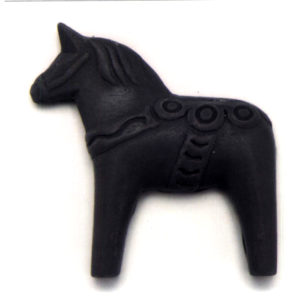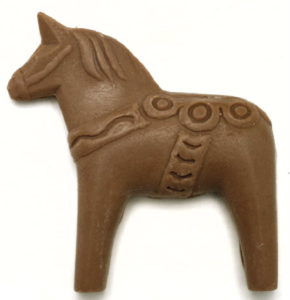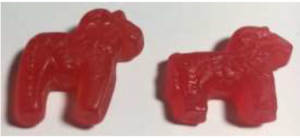In a recent case from the Swedish Patent and Market Court, the court dismissed Dalecarlia Chocolates AB’s (Dalecarlia) infringement claim of their EU and Swedish 3D marks in relation to chocolate, candy and confectionery (class 30). The 3D marks, depicted below, are formed as a Dala horse – a traditional, wooden horse statue originating from the Swedish province Dalarna (Dalecarlia).
The case
Dalecarlia sued Candy People AB (Candy People) for marketing, manufacturing and distributing the candy shown below, arguing that such use infringed Dalecarlia’s rights. Dalecarlia requested the court to prohibit Candy People’ use of these products.
Product 1 Product 2
Candy People argued that the Dala horse is a famous symbol and that Dalecarlia’s registration did not cover everything resembling a Dala horse, and even less so a horse.
The judgment
First, the court established that both Product 1 and Product 2 were candy, and thus identical to the goods covered by the registrations. Regarding the distinctiveness of the registered marks, the court held that the Dala horse is an old and famous symbol for Dalarna. At the time of registration of Dalecarlia’s marks, several trademarks depicting Dala horses were already registered in class 30. The Swedish Patent and Registration Office has also noted that it only accepted the registration because the scope of protection of a Dala horse is limited. Moreover, the court noted that the registrations are 3D marks. As the average consumer is not used to see a 3D mark as an indication of commercial origin, it is difficult to establish distinctiveness in such marks. Nor was there any indication that these marks have acquired enhanced distinctiveness through use. The distinctiveness of the registered marks is therefore considered limited to the specific combination of the horse’s silhouette, colour and decorations. The scope of protection of the horses must therefore be limited.
Considering the low degree of distinctiveness, the court noted the visual differences between the horses. The distinctive elements of Dalecarlia’s horse – the silhouette, colour and decorations – is missing in Candy People’s products. Further, the conceptual similarity was limited to a Dala horse (Product 1) and a horse (Product 2 – difficult to recognize as a horse, impossible to recognize it as a Dala horse according to the court). The similarity of the marks was therefore low.
In the global assessment, the court noted that Dalecarlia held no exclusive right to use Dala horses as such as a trademark for candy. The conceptual similarity between the marks was therefore of less importance. Considering the visual differences, the court concluded no likelihood of confusion and, as such, no infringement.
Reflections
When assessing the distinctiveness of the 3D marks, the court did not use the well-established EUCJ criteria (a shape must depart significantly from the norms or customs of the section). Instead, the court suggested that the distinctiveness of all 3D marks are inherently low. This sets a very high bar for 3D mark owners in infringement cases and we question whether this is consistent with EUCJ’s practice. However, it is unlikely that this affected the outcome, as the court also concluded that the concept of a Dala horse is weak. The judgement is still appealable, and it will be interesting to see if Dalecarlia takes it for another round.
_____________________________
To make sure you do not miss out on regular updates from the Kluwer Trademark Blog, please subscribe here.
Kluwer IP Law
The 2022 Future Ready Lawyer survey showed that 79% of lawyers think that the importance of legal technology will increase for next year. With Kluwer IP Law you can navigate the increasingly global practice of IP law with specialized, local and cross-border information and tools from every preferred location. Are you, as an IP professional, ready for the future?
Learn how Kluwer IP Law can support you.





